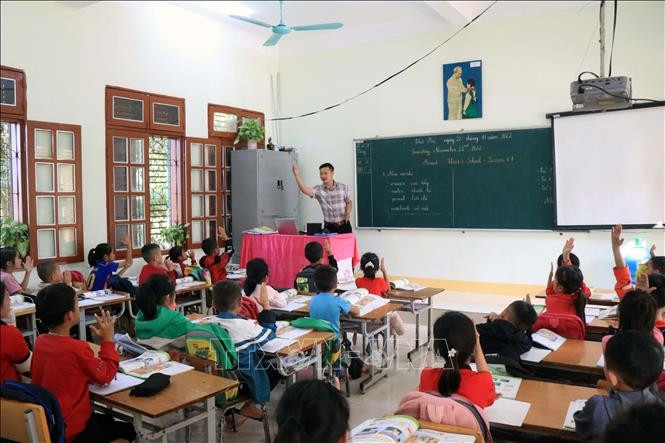The 2018 general education program has been implemented for grades 1, 2, 3, 6, 7 and 10 in 63 provinces and cities across the country, synchronously in all localities, regions and areas.

English class for third graders at Muong Te Primary and Secondary School, Van Ho district. Illustrative photo: Huu Quyet/VNA
The report of the Ministry of Education and Training on the implementation of innovation in general education programs and textbooks shows that the education sector has initially achieved positive results.
Specifically, the 2018 General Education Program was issued in accordance with the orientation and requirements for fundamental and comprehensive innovation in education and training according to Resolution 29 of the Party and Resolution 88 of the National Assembly. Guidance on developing and implementing the school's education plan ensures the flexible implementation of the Program, suitable to the specific conditions of the locality and educational institution.
The preparation of conditions regarding teaching staff and facilities to implement the new curriculum and textbooks in localities basically meets the requirements. Schools have promoted initiative and flexibility in teaching, learning, testing and evaluation, basically meeting the requirements of the new curriculum.
However, the Ministry of Education and Training also pointed out a number of existing problems and limitations in the implementation process related to textbooks, teaching staff, and facilities.
Accordingly, the compiled textbooks still have some inappropriate content such as using local words, poor language materials, and information that is not suitable for students. Because the Government submitted to the National Assembly Resolution 122 on not organizing the compilation of a set of textbooks (under the leadership of the Ministry of Education and Training), the compilation and testing of electronic textbooks and the translation of textbooks into Braille according to this set of books have not been implemented.
The issuance of elective programs for ethnic minority languages, foreign languages 2 and foreign languages 1 other than English is still slower than other subjects. The compilation and appraisal of local educational materials is still slow and late, causing difficulties in implementing the new program.
The teaching staff is not uniform in structure, there is a shortage in some areas, especially the shortage of primary school teachers, and the shortage of music and art teachers at the high school level. The quality of the staff is uneven, especially in areas with difficult socio-economic conditions.
The shortage of schools still occurs, especially in some urban areas, industrial parks, export processing zones, remote areas, and areas with special difficulties. Some localities have mechanically consolidated educational facilities or built substandard schools, and purchased teaching equipment that has not ensured progress.
To resolve the above problems, the Ministry of Education and Training recommends a number of solutions to effectively implement the new general education program.
For the National Assembly, the Ministry of Education and Training recommends that agencies, when appraising the annual budget allocation plan, ensure the criteria for allocating regular budget expenditures for the education and training sector to ensure the budget ratio for education according to Resolution No. 37/2004/NQ-QH11 of the National Assembly and the 2019 Education Law; separate development investment expenditures for the education sector to ensure the minimum total expenditure as prescribed.
Regarding the preparation of facilities, the Ministry of Education and Training proposed that the National Assembly allow the Government to continue to allocate capital to implement the program of solidifying schools and classrooms in the 2021-2025 period (priority given to mountainous, border, island areas, areas with large ethnic minorities; provinces, regions with slow economic development, with particularly difficult socio-economic conditions, localities frequently affected by natural disasters and epidemics). The National Assembly considers and promulgates a special allowance regime for teachers and education managers.
Localities review and determine investment needs, develop plans and investment capital sources for the 2021-2025 period of the Project "Ensuring facilities for preschool education programs and general education programs"; study and propose priority investment and construction items and locations.
Localities arrange central capital sources to support disadvantaged localities to invest in strengthening facilities to meet the implementation of the new general education program.
At the same time, localities should consider putting projects and tasks related to the education sector in the top priority group when developing principles and criteria for allocating capital planning limits, in which priority should be given to purchasing teaching equipment, renovating and upgrading facilities, consolidating schools, and essential auxiliary works serving teaching and learning conditions to ensure material conditions for implementing the Program.
Along with that, localities issue specific policies for education on regular expenditures to ensure conditions for improving the quality of education; implementing policies on learning for students; policies to support educational development for children of ethnic minorities; funding to support scholarships and support means and learning materials to implement educational policies for students with disabilities.
Localities need to properly exercise their authority and responsibility in selecting textbooks. The selection of textbooks must be carried out publicly, transparently, in accordance with the law and the selection process, and strictly based on proposals from professional groups of general education institutions. Localities are responsible for organizing the compilation and appraisal of local educational materials. In fact, the compilation and appraisal of local educational materials in some localities is still slow, causing difficulties in implementing the program.
Localities are also responsible for ensuring the conditions for implementing the 2018 General Education Program (facilities, teaching staff, teaching equipment). Currently, some localities have not ensured facilities; the teaching staff is still locally surplus or shortage; the purchase of minimum teaching equipment is slow, affecting the organization of teaching and learning in general education institutions.
According to VNA